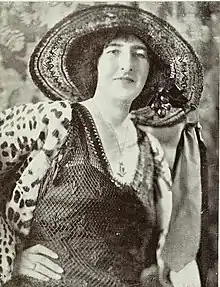Nell St. John Montague
Nell St. John Montague (27 June 1875 – 23 August 1944) was the pen name of a British actress, writer, socialite and "clairvoyante", born Eleanor Lucie-Smith in India.
Nell St. John Montague | |
|---|---|
 Nell St. John Montague, from a 1921 publication. | |
| Born | Eleanor Lilian Helene Lucie-Smith 27 June 1875 Jabalpur, India |
| Died | 23 August 1944 London |
| Nationality | British |
| Other names | Nell St. John Montagu, Eleanor Standish-Barry (after marriage) |
| Occupation | writer, actress, fortune teller |
Early life
Eleanor Lilian Helene Lucie-Smith was born in Jabalpur, India, to an English father and a Scottish mother. Her father, Major-General Charles Bean Lucie-Smith, was stationed there with the British Army.[1]
Career
Montague wrote The Irish Lead (1916), a play she also directed and acted in, to raise funds for Irish prisoners-of-war.[2] She also starred in An Interrupted Divorce in London, and her own short play, The Barrier. In 1922 she wrote and appeared in a one-act farce, Room 7, on the London stage.[3] She appeared in two silent films, The Glorious Adventure (1922)[4] and A Gipsy Cavalier (1923).[5] She wrote the anti-vivisection short story "The Hallmark of Cain", which was adapted into the short film All Living Things (1939).[6] The film was remade in 1955.[7]
Montague called herself a "clairvoyante", and her fortune telling was popular in society circles.[8][9][10] She appeared on very early British television, in 1932, reading palms, and "her performance evoked a volume of mail at Portland Place that would have been gratifying to the producer of a popular revue", according to one report.[11] She was invited to the wedding of Princess Marina of Greece and Denmark in 1934, and brought a crystal ball as a gift.[12] She also tried to use her visions to solve crimes.[13] She kept a pet monkey, and posed with the monkey for portraits, saying it brought good luck.[8] She wrote about her abilities and her predictions in her memoir, Revelations of a Society Clairvoyante (1926),[1] and in The Red Fortune Book (1924). She also wrote a novel, The Poison Trail (1930).[14]
Personal life
Montague married Irish landowner and judge Henry Standish-Barry (1873-1945) in 1899.[15] They had three children, Charles (1900-1918), Marcella (Mercy), and Margaret. Her son died in World War I. She died in 1944, in London, aged 69 years, in a bombing during World War II. It was widely publicized that she predicted the violent circumstances of her death, when she said "I saw a fiery streak. Then a red mist spread over everything."[13] Her gravesite is in Bishopstone, East Sussex. Her name appears on a memorial plaque commemorating the war dead in Bishopstone.[2]
References
- Montagu, Nell St John (1926). Revelations Of A Society Clairvoyante By Nell St John Montague. Thornton Butterworth Ltd. pp. 11–12.
- Gordon, Kevin (2018-02-21). "A War-Memorial Mystery!". Quirky Sussex History. Retrieved 2019-08-15.
- Wearing, J. P. (2014-03-27). The London Stage 1920-1929: A Calendar of Productions, Performers, and Personnel. Rowman & Littlefield. p. 23. ISBN 9780810893023.
- "Nell St. John Montague". The Motion Picture Studio. 1: 22. July 16, 1921 – via Internet Archive.
- "Title Found for Charpentier Vehicle". The Washington Times. August 20, 1922. p. 36. Retrieved August 15, 2019 – via Newspapers.com.
- Gifford, Denis (2016-04-01). British Film Catalogue: Two Volume Set - The Fiction Film/The Non-Fiction Film. Routledge. p. 487. ISBN 9781317740636.
- Goble, Alan (2011-09-08). The Complete Index to Literary Sources in Film. Walter de Gruyter. p. 667. ISBN 9783110951943.
- "The Raconteur". The Gazette. March 12, 1927. p. 18. Retrieved August 15, 2019 – via Newspapers.com.
- "Miss Nell St. John Montague". Star-Phoenix. August 30, 1926. p. 12. Retrieved August 15, 2019 – via Newspapers.com.
- Greene, Richard (2011-11-10). Edith Sitwell: Avant Garde Poet, English Genius. Little, Brown Book Group. ISBN 9781405511070.
- Herbert, Stephen (2004). A History of Early Television. Taylor & Francis. ISBN 9780415326667.
- "DUKE'S FAVORITE TUNE". Advocate (Burnie, Tas. : 1890 - 1954). 1934-12-29. p. 5. Retrieved 2019-08-15 – via Trove.
- "Clairvoyant's Crystal Told Her Own Fate". The American Weekly. November 12, 1944. p. 12. Retrieved August 15, 2019 – via Google News.
- "Advertisement". The Observer. November 9, 1930. p. 9. Retrieved August 15, 2019 – via Newspapers.com.
- Burke's Genealogical and Heraldic History of the Landed Gentry of Ireland. Burke's Peerage, Limited. 1904. p. 22.
External links
- Nell St. John Montague at IMDb
- Nell St. John Montague at the British Film Institute
- Will Gray, "Standish Barry of Leamlara" Forgotten Victorians (May 8, 2016); a blogpost about Nell St. John Montague's husband's family, mentioning her and her children.